Monday, October 13, 2014
Browse »
home »
amplifier
»
and
»
Charecteristics
»
circuit
»
explanation
»
for
»
Signal
»
tv
»
Signal Amplifier For TV explanation Charecteristics and circuit
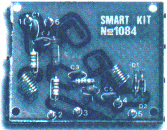
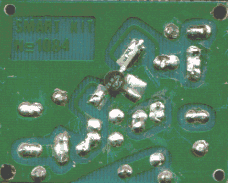
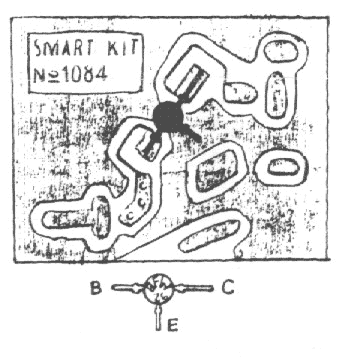
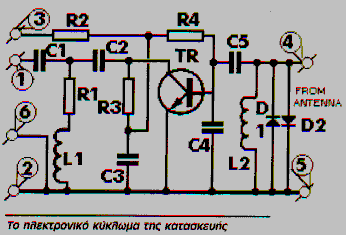
Construction
First of all let us consider a few basics in building electronic circuits on a printed circuit board. The board is made of a thin insulating material clad with a thin layer of conductive copper that is shaped in such a way as to form the necessary conductors between the various components of the circuit. The use of a properly designed printed circuit board is very desirable as it speeds construction up considerably and reduces the possibility of making errors. Smart Kit boards also come pre-drilled and with the outline of the components and their identification printed on the component side to make construction easier. To protect the board during storage from oxidation and assure it gets to you in perfect condition the copper is tinned during manufacturing and covered with a special varnish that protects it from getting oxidised and also makes soldering easier.
Soldering the components to the board is the only way to build your circuit and from the way you do it depends greatly your success or failure. This work is not very difficult and if you stick to a few rules you should have no problems. The soldering iron that you use must be light and its power should not exceed the 25 Watts. The tip should be fine and must be kept clean at all times. For this purpose come very handy specially made sponges that are kept wet and from time to time you can wipe the hot tip on them to remove all the residues that tend to accumulate on it. DO NOT file or sandpaper a dirty or worn out tip. If the tip cannot be cleaned, replace it. There are many different types of solder in the market and you should choose a good quality one that contains the necessary flux in its core, to assure a perfect joint every
time.
DO NOT use soldering flux apart from that which is already included in your solder. Too much flux can cause many problems and is one of the main causes of circuit malfunction. If nevertheless you have to use extra flux, as it is the case when you have to tin copper wires, clean it very thoroughly after you finish your work. In order to solder a component correctly you should do the following:
- Clean the component leads with a small piece of emery paper.
- Bend them at the correct distance from the component’s body and insert the component in its place on the board.
- You may find sometimes a component with heavier gauge leads than usual, that are too thick to enter in the holes of the p.c. board. In this case use a mini drill to enlarge the holes slightly. Do not make the holes too large as this is going to make soldering difficult afterwards.
- Take the hot iron and place its tip on the component lead while holding the end of the solder wire at the point where the lead emerges from the board. The iron tip must touch the lead slightly above the p.c. board.
- When the solder starts to melt and flow, wait till it covers evenly the area around the hole and the flux boils and gets out from underneath the solder. The whole operation should not take more than 5 seconds. Remove the iron and leave the solder to cool naturally without blowing on it or moving the component. If everything was done properly the surface of the joint must have a bright metallic finish and its edges should be smoothly ended on the component lead and the board track. If the solder looks dull, cracked, or has the shape of a blob then you have made a dry joint and you should remove the solder (with a pump, or a solder wick) and redo it.
- Take care not to overheat the tracks as it is very easy to lift them from the board and break them.
- When you are soldering a sensitive component it is good practice to hold the lead from the component side of the board with a pair
of long-nose pliers to divert any heat that could possibly damage the component.
- Make sure that you do not use more solder than it is necessary as you are running the risk of short-circuiting adjacent tracks on the board, especially if they are very close together.
- When you finish your work, cut off the excess of the component leads and clean the board thoroughly with a suitable solvent to
remove all flux residues that may still remain on it.
The project is a very easy one, as the components which form the circuit are very few and their outlines have been clearly stencilled on the board for you. The only unusual thing is that the transistor must be soldered from the copper side of the board. This is, however, common with UHF devices and is usually done to avoid the introduction of stray capacitances between the transistor’s leads that could possibly alter the behaviour of the circuit. Be careful to make good joints and try to keep the component leads as short as possible because of the very high frequencies involved. Solder first of all the pins and the resistors. The coils are supplied ready to be soldered on the printed circuit and you
should take care not to deform them in the process. Place then the capacitors and solder the diodes carefully trying to avoid overheating them and making sure that they are correctly aligned. Solder the transistor in its place, after you have finished soldering the other components, to avoid overheating it, and be careful to align it according to the diagram included in the instructions. (The lettering on the transistor body should be facing away from the copper). The input of the circuit is at point 4 and ground and the output at point 1 and ground. The battery is connected using the battery clip supplied at points 2 (-) and 3 (+), and is a miniature 9 V one, alkaline if you prefer. For best performance and to avoid unwanted interference during operation it is recommended to place the circuit in a small metal box, and use suitable connectors mounted on the box for the external connections. You can use a box large enough to house the amplifier and the battery or you can use an external power supply, but remember to use a FEED THROUGH capacitor on the positive supply line, where it passes through the metal box. If you plan to use the amplifier for both VHF and UHF TV reception you should use a common VHF/UHF mixer before the amplifier’s input.
Signal Amplifier For TV explanation Charecteristics and circuit
This is a small, broad band, signal amplifier which covers the frequencies from 40 to 900 MHz. These frequencies include TV in VHF and UHF and also the radio broadcasting frequencies in the 88 - 108 MHz FM band.
It is connected between the antenna and the input of your receiver and boosts the signals by up to 20 dB, thus making it possible to receive even the weakest signals.
It is connected between the antenna and the input of your receiver and boosts the signals by up to 20 dB, thus making it possible to receive even the weakest signals.
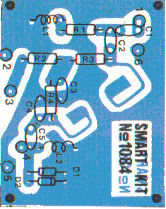 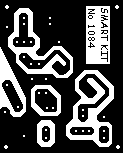 Dimensions (4,3cm x 5,4cm) |


| Technical Specifications -Characteristics Frequency response: 40 - 900 MHz Gain: . 20 dB Maximum output level: 90 uV Input - output impedance: 75 ohm |
How it Works
The circuit is built around a single transistor a UHF low signal device, the BFW 92. This transistor can operate in frequencies as high as 1.6 GHz, and has a gain of 23 dB. The signal from the antenna is applied to the input of the circuit and through C5 is fed to the base of the transistor. It is amplified and from the collector of the BFW 92 through C2 and C1 is taken to the input of the radio or TV receiver.
The circuit operates off a small 9 V battery which, because of the very low power consumption of the circuit, is going to last for a very long time.
The circuit is built around a single transistor a UHF low signal device, the BFW 92. This transistor can operate in frequencies as high as 1.6 GHz, and has a gain of 23 dB. The signal from the antenna is applied to the input of the circuit and through C5 is fed to the base of the transistor. It is amplified and from the collector of the BFW 92 through C2 and C1 is taken to the input of the radio or TV receiver.
The circuit operates off a small 9 V battery which, because of the very low power consumption of the circuit, is going to last for a very long time.


Construction
First of all let us consider a few basics in building electronic circuits on a printed circuit board. The board is made of a thin insulating material clad with a thin layer of conductive copper that is shaped in such a way as to form the necessary conductors between the various components of the circuit. The use of a properly designed printed circuit board is very desirable as it speeds construction up considerably and reduces the possibility of making errors. Smart Kit boards also come pre-drilled and with the outline of the components and their identification printed on the component side to make construction easier. To protect the board during storage from oxidation and assure it gets to you in perfect condition the copper is tinned during manufacturing and covered with a special varnish that protects it from getting oxidised and also makes soldering easier.
Soldering the components to the board is the only way to build your circuit and from the way you do it depends greatly your success or failure. This work is not very difficult and if you stick to a few rules you should have no problems. The soldering iron that you use must be light and its power should not exceed the 25 Watts. The tip should be fine and must be kept clean at all times. For this purpose come very handy specially made sponges that are kept wet and from time to time you can wipe the hot tip on them to remove all the residues that tend to accumulate on it. DO NOT file or sandpaper a dirty or worn out tip. If the tip cannot be cleaned, replace it. There are many different types of solder in the market and you should choose a good quality one that contains the necessary flux in its core, to assure a perfect joint every
time.
DO NOT use soldering flux apart from that which is already included in your solder. Too much flux can cause many problems and is one of the main causes of circuit malfunction. If nevertheless you have to use extra flux, as it is the case when you have to tin copper wires, clean it very thoroughly after you finish your work. In order to solder a component correctly you should do the following:
- Clean the component leads with a small piece of emery paper.
- Bend them at the correct distance from the component’s body and insert the component in its place on the board.
- You may find sometimes a component with heavier gauge leads than usual, that are too thick to enter in the holes of the p.c. board. In this case use a mini drill to enlarge the holes slightly. Do not make the holes too large as this is going to make soldering difficult afterwards.
- Take the hot iron and place its tip on the component lead while holding the end of the solder wire at the point where the lead emerges from the board. The iron tip must touch the lead slightly above the p.c. board.
- When the solder starts to melt and flow, wait till it covers evenly the area around the hole and the flux boils and gets out from underneath the solder. The whole operation should not take more than 5 seconds. Remove the iron and leave the solder to cool naturally without blowing on it or moving the component. If everything was done properly the surface of the joint must have a bright metallic finish and its edges should be smoothly ended on the component lead and the board track. If the solder looks dull, cracked, or has the shape of a blob then you have made a dry joint and you should remove the solder (with a pump, or a solder wick) and redo it.
- Take care not to overheat the tracks as it is very easy to lift them from the board and break them.
- When you are soldering a sensitive component it is good practice to hold the lead from the component side of the board with a pair
of long-nose pliers to divert any heat that could possibly damage the component.
- Make sure that you do not use more solder than it is necessary as you are running the risk of short-circuiting adjacent tracks on the board, especially if they are very close together.
- When you finish your work, cut off the excess of the component leads and clean the board thoroughly with a suitable solvent to
remove all flux residues that may still remain on it.
The project is a very easy one, as the components which form the circuit are very few and their outlines have been clearly stencilled on the board for you. The only unusual thing is that the transistor must be soldered from the copper side of the board. This is, however, common with UHF devices and is usually done to avoid the introduction of stray capacitances between the transistor’s leads that could possibly alter the behaviour of the circuit. Be careful to make good joints and try to keep the component leads as short as possible because of the very high frequencies involved. Solder first of all the pins and the resistors. The coils are supplied ready to be soldered on the printed circuit and you
should take care not to deform them in the process. Place then the capacitors and solder the diodes carefully trying to avoid overheating them and making sure that they are correctly aligned. Solder the transistor in its place, after you have finished soldering the other components, to avoid overheating it, and be careful to align it according to the diagram included in the instructions. (The lettering on the transistor body should be facing away from the copper). The input of the circuit is at point 4 and ground and the output at point 1 and ground. The battery is connected using the battery clip supplied at points 2 (-) and 3 (+), and is a miniature 9 V one, alkaline if you prefer. For best performance and to avoid unwanted interference during operation it is recommended to place the circuit in a small metal box, and use suitable connectors mounted on the box for the external connections. You can use a box large enough to house the amplifier and the battery or you can use an external power supply, but remember to use a FEED THROUGH capacitor on the positive supply line, where it passes through the metal box. If you plan to use the amplifier for both VHF and UHF TV reception you should use a common VHF/UHF mixer before the amplifier’s input.
PARTS
R1 = 120 Ohm (brown, red, brown)
R2 = 1,5 KOhm (brown, green, red)
R3 = 270 Ohm (red, violet, brown)
R4 = 82 KOhm (gray, red, orange)
C1,C5 = 100pF (ceramic)
C2,C3 = 1nF (ceramic)
C4 = 2,2pF (ceramic)
D1,D2 = 1N4148 diode
Transistor = BFR90, BFR91, BFW92
Misc = PCB, 6pins, solder, 9V battery clip
R2 = 1,5 KOhm (brown, green, red)
R3 = 270 Ohm (red, violet, brown)
R4 = 82 KOhm (gray, red, orange)
C1,C5 = 100pF (ceramic)
C2,C3 = 1nF (ceramic)
C4 = 2,2pF (ceramic)
D1,D2 = 1N4148 diode
Transistor = BFR90, BFR91, BFW92
Misc = PCB, 6pins, solder, 9V battery clip
Labels:
amplifier,
and,
Charecteristics,
circuit,
explanation,
for,
Signal,
tv
Subscribe to:
Post Comments (Atom)
No comments:
Post a Comment